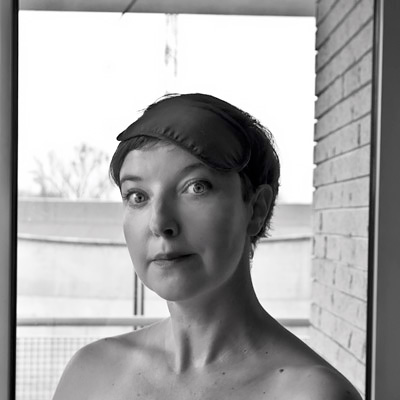Urszula Tarasiewicz, Photographer, organizer of events and photo exhibitions. Studied at the National Film School in Łódź, Poland.
I produce pictures with a medium format Hasselblad, which for me retains a particular sort of magic. The quality, the way light works on film, always elevates my interest when I decide to shoot a particular subject. The 'truth in photography' is a continuous debate. But that idea has always fascinated me. I observe the space around me, searching for a contrast between people and their environments. At times I allow the subject to play different roles or use simple props to alter the mood in the picture. There are many stories you can choose from when you observe the picture. I like the viewer to question its authenticity. For me, it's the interpretation that creates the magic. - Urszula Tarasiewicz
Her photographs are the effect of acute observation of her surroundings and the ability to notice intriguing details and phenomena which are sometimes absurd and marginal, sometimes sentimental reminiscences of the People's Republic of Poland and the birth of the capitalism in Poland.
Marcin Krasny
The artist's eye focuses on the margins of reality, the kitsch and grotesque public space. Simple, plain and ascetic compositions, or quite the opposite - full of details, colorful - frames of Urszula Tarasiewicz's works depict the world as a place which is not as much absurd as it is pleasant and charming- Anna Czaban - Art Historian
Urszula Tarasiewicz /b. 1975/ studied Photography at the Leon Schiller National Higher School of Film, Television and Theatre in Łódź, Poland. The works from the series New Urban Legends which are on display at the andel's Hotel in Łódź /curator Lucyna Sosnowska/ have won the portrait category at the 2010 Curator's Contest of the Photo District News Magazine, the 2012 New Talent Award of the German edition of the FotoMagazine, as well as the contest of the Norwegian photography magazine Fotografii for a place at the 17#Debutantutstilling 2012 exhibition in Oslo. The New Urban Legends series has been exhibited in, among others, the Milk Gallery NYC (2010).
Other photo series by Urszula Tarasiewicz have been shown internationally: in the US at the Critical Mass exhibition (2012), the series The Future Is So Bright created in Norway during the Artist in Residence program at the Halsnøy monastery was presented at a group exhibition in Norway in 2013 and in Warsaw in 2015 at the Ja to Ktoś Inny show /curator Klima Boheńska/, at the Krinzinger Galerie in Vienna during the group exhibition Call Me on Sunday (2014, curator Ursula Maria Probst), at the Jam Factory gallery in Oxford (2014), in Stuttgart at the Face to Face show (2014), at the Bunkier Sztuki gallery in Kraków during the show Kasa z Widokiem /curator Lidia Krawczyk.
Ogrodowa/Garden Street
Garden Street, A project documenting flats after evictions on Garden Street. 150 families left the building. It was the first residential complex for workers in 1880 in the new industrial city of Lodz.
Izrael Poznański wealthy entrepreneur (1833-1900) is regarded as being one of the icons of Łódź. His monumental factory just across Ogrodowa street along with the labourers' tenement houses, is a true city within a city. In its best years, nearly 7000 people in total worked and lived here.
The moment Poznański's empire fell after World War II was the beginning of the estate's and all of its inhabitants' long agony. Its fate was concluded with the decommissioning of the Poltex company in 1991. Famuły became a no man's land, its residents left to their own devices.
The project 100 Tenement houses in Łódź, thanks to which a major renovation of the Poznański's factory housing estate started in 2014 was preceded by a long process of relocating all the residents. It was during this time I began to document the empty flats. The famuły rooms stun with their ruthlessness, their coldness, with the visibly absent inhabitants.
The artist guides us around the world which is already gone, lost. Looking at Tarasiewicz's photos, we're confronted with desolate rooms, dilapidated walls out of which someone ripped off electrical wiring and where time imprinted the ghosts of furniture and lost artworks.
